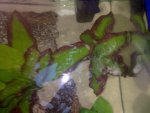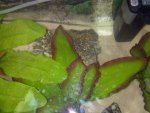Look MereB, I'm just asking a simple question, there no need to attack me about this.
For the record I do find the majority of what you say in a "discussion" condescending, and I fail to see where I misquoted you. If I'm incorrect in my info I like to be corrected, but because I assume we're all adults here (right?) I'd like to have it in a civilized manner. Now if you can just take a deep breath and calm down, (or ignore my post, whatever floats your boat I don’t care) I’d like to clarify some of your points.
Relevance of Total Ammonia Nitrogen
I wasn't bringing in the discussion of NH3 and NH4 to seem "clever", it is a relevant point. .5 ppm's of total ammonia is not in the danger zone, however .5 ppm's of NH3 is considered deadly. I was unaware that there was a difference between NH3, and NH4 up until this point, and like to clarify so other people can learn. You may be under a different impression, but I think the point of forums like these is to learn. Just because I disagree with you over subjects does not mean I'm attacking you, and I don't know why you always address my arguments as personal attacks. I was just curious as to where you got the information about the proportion of NH3 to NH4 found in water, as I like to check my facts and your information was flawed to my knowledge. While you are correct, there are other considerations besides ph, and temperature, there are many other charts similar to the conversion calculator that have the same guidelines, so I think it has some decent relevance. Like you said ammonium is not nearly as dangerous as ammonia, so I think it makes a big difference to say over half of the concentration in someone’s tank is NH3, when in reality it is less than 1%. I find this has so much more relevance than you telling me I’ve missed the point of a question. If I was indeed trying to make myself seem “clever” I would probably be talking in a condescending manner, and giving out suggestions to people over information I doubt they know, because everyone should know I’m better than them.
Solution to Problem (Axolotl near surface, floating vs. ammonia poisoning)
I agree that the safest way to address ammonia problems is a water change, however Gem was asking what could be the likely cause of film on her tank, and her axolotl being at the surface. Because I assumed most people would instantly think of the ammonia problem, I addressed it, and explained why I did not think floating near the surface was due to ammonia. According to most websites NH3 is not considered harmful until .02 ppm's. If the total ammonia was .5, I would be less likely to assume that being at the top of the tank is due to ammonia poisoning, and more likely that the axolotl is just floating, because .0019 ppm's of NH3 is not considered super harmful(hence the relevance). If it was .5 ppm's of NH3 then the axolotl would be in considerably more danger.
I find it interesting that you talk about me trotting about information that is "irrelevant" when you yourself talk about so much more irrelevant information, including information to learn up on. I too think it's important to correct incorrect information, such as that 1/2 the concentration in your total ammonia reading is NH3, and I just like to get the facts straight. I don’t think this information is useless, and I have no doubt the common hobbyist can understand this if I can (in fact the average hobbyist is more likely to understand this quicker than me). If you want to give me bad rep’s for “misquoting” you (and by that I mean explaining why I’m referring to certain aspects of a conversation), than by all means go for it.



